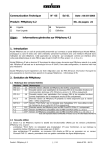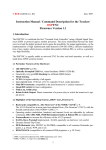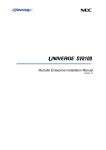Download CTI Installation Manual Version 1.06
Transcript
CTI Installation Manual Version 1.06 Document History July 2009 Initial Release. Sept 2009 Revised to include Hotdesking. May 2010 Add Server 2008 / 64 BIT support. Nov 2010 Add enable / disable TAPI client. Jan 2011 –Add Outlook dialling rules / Add IP Address of CTI Device April 2012 –Added SBS support, Citrix and Virtual Server environment Feb 2013 – Add Windows 8 / Server 2012 support Table of Contents General Description ....................................................................... 4 1st Party CTI.................................................................................... 5 Requirements....................................................................................................................................... 5 Configuring the SV8100 ....................................................................................................................... 6 st Installing the 1 Party TSP .................................................................................................................. 7 Un-Installing the 1st Party Driver ....................................................................................................... 13 3rd Party CTI ................................................................................. 14 Requirements..................................................................................................................................... 14 Configuring the SV8100 ..................................................................................................................... 15 Installing the 3rd Party Driver ............................................................................................................ 16 rd Configuring the 3 Party TSP ............................................................................................................ 20 Enabling TAPI Server ........................................................................................................................ 24 Windows 2003 Server ........................................................................................................................ 24 Windows 2008 ................................................................................................................................... 28 Windows Small Business Server ....................................................................................................... 29 Assigning Users to Extensions. ......................................................................................................... 30 Enabling TAPI Client .......................................................................................................................... 36 Disabling TAPI Client ......................................................................................................................... 37 Uninstalling the 3rd Party TAPI Driver ............................................................................................... 38 TAPI in a Citrix Environment ......................................................... 40 Citrix XenDesktop........................................................................................................ 40 Citrix XenApp .............................................................................................................. 41 Hotdesking with CTI ..................................................................... 42 3rd Party CTI IP Address ................................................................ 43 Outlook Dialing Rules ................................................................... 43 General Description The primary function of Computer Telephony Integration (CTI) is to allow a PC based application to use an SV8100 telephone extension. The most common functions of these applications are to perform Screen popping and call control. There are two modes of CTI that can be used on the SV8100, 1st Party and 3rd Party. 1st Party CTI (TAPI 1.4) runs over a LAN and is designed to allow you to connect an SV8100 telephone extension to a PC via the Ethernet connection on the SV8100. It is aimed for smaller office of between 1 and 10 users. The 1st Party driver is installed onto each PC that needs to run 1st Party CTI and talks directly to the SV8100. 3Rd Party CTI employs a similar concept, running on a LAN to allow a user to control their extension using a TAPI application. The driver used for 3 rd Party CTI is installed on to a CTI Server that is responsible for all of the TAPI communication to the SV8100 from all of the TAPI clients. Both drivers can connect to either the CCPU or an IPLA/B depending on which is being used. CTI is a licensed module on the SV8100 and will only work when the appropriate licenses are installed on the CPU. BE107580 - 1st Party CTI (0111) BE107577 - 3rd Party CTI (0112) The CTI interface is provided ‘as-is’, without support of any kind including but not limited to the support and warranty for fitness for a particular purpose or 3rd party application. In no event NEC Unified Solutions is liable for any claim, damage or other liability, whether in action of contract, tort or otherwise, arising from, out of or in connection with the use or other dealing on this interface. 1st Party CTI Requirements Following are the minimum specifications required to use 1st Party CTI over LAN. Telephone System SV8100 Running version 8 or above software and a TCPIP connection to either the CCPU or the IPLA/B Operating System Windows 2000 Professional SP4 (32 Bit Only) Windows XP Professional Min SP2 (32 Bit Only) Windows Vista Business, Ultimate, Enterprise (32 Bit Only) Windows 7 Professional, Ultimate, Enterprise (32/64 Bit) Windows 8 Professional, Windows 8 Enterprise (32/64 Bit) Windows Server 2003 (32 Bit Only) Windows Server 2008 (32 Bit Only) Windows Server 2008 R2 (64 Bit Only) Windows Small Business Server 2003 (32 Bit Only) Windows Small Business Server 2008 (64 Bit Only) Windows Small Business Server 2011 (64 Bit Only) Windows Server 2012 (64 Bit Only) 2.5GHZ 1GB Using TCP/IP (Including WINS, DNS services), PC CPU Memory Network Card A Maximum of 128 1st Party CTI clients can be used on an SV8100. The setup requires you to be logged onto the PC Server as a Local Administrator. If a firewall is present Port 8282 should be made an exception so as not to block/delay TAPI information. Note: The above are the specification for TAPI set-up only. They may differ when you install an application. Configuring the SV8100 The SV8100 should have an IP address assigned to the CCPU or IPLA card that is connected to the network. A TCP Port has to be assigned to the 1st Party CTI driver to connect to, the recommended port is 8282. Assign the port in Wizards / Advanced Items / CTI / CTI LAN Port Setup (PRG 10-20 Dev9.) Set the 1st Party CTI TCP Port to 8282. A license is required for each 1st Party CTI client that will be concurrently used (BE107580). You can use 128 1st party CTI clients when the 60 day license is running. If using Aspire Phones (Model C) programming command 15-02-53 must be set to a 1. This changes the operation of the phone to a DT3xx/7xx Installing the 1st Party TSP Before you can install the software, you have to logon to the PC as an administrator. To install the 1st Party TSP, extract the software from the technical DVD and run the ‘Setup.exe’ application. At the welcome screen, click next. Choose the folder that the TSP will be installed to and click next. Use the browse button to select a different location should you need to. Enter the extension number that will be associated with the PC and click next. Enter the IP Address of the SV8100 and the TCP Port that was assigned when configuring the SV8100 (10-20-09), this is usually 8282. Leave to ‘This PC hostname of IP Address’ set a ‘localhost’ and click next to continue. Before the software actually goes off and installs, you can review the options that have been configured. Click next to continue. After the software has installed, the TSP will initialise, once initialised, the configuration screen is displayed. Under the Communication Status, you can see if the TSP is connected to the SV8100. Click ok to continue. Select Yes, I want to restart my computer now and click finish to complete the installation. The Machine must now be restarted. To review the configuration of the 1st Party TSP, look in Control Panel / Phone and Modem Options / Advanced and select NEC Infrontia Telephone Service Provider. Click the Configure button and you are able to change any of the options. To change any of the information, over type the existing text and click OK. Any changes that are made will require a reboot in order to take effect. Un-Installing the 1st Party Driver To remove the TSP from a PC, go into Control Panel / Add and Remove Programs, find ‘NEC Infrontia Telephony Driver (1st)’, and then click Remove. When prompted, click Yes to begin removing the TSP. To complete the un-installation, the PC will need to be restarted. Either select Yes or No and click Finish. 3rd Party CTI Requirements Following are the minimum specifications required to use 3st Party CTI. Depending on what type of TAPI application will be used, it may be necessary to use a Windows Server. The 3rd Party TSP is installed on to the PC acting as the TAPI server. Some TAPI applications take responsibility for the communications between their application and the TAPI server. Other applications need to have the TAPI enabled on each PC. If TAPI has to be enabled on client PC’s then a Windows Server operating system is required. If TAPI communications is handled by the TAPI application then any of the operating listed below can be used. Telephone System SV8100 Running version 8 or above software and a TCPIP connection to either the CCPU or the IPLA/B Operating System Windows Server 2000 Server SP4 (32Bit Only) Windows Server 2003 SP2 (32Bit Only) Windows Server 2008 (32 / 64 Bit) Windows 2000 Professional SP4 (32 Bit Only) *Note 1 Windows XP Professional Min SP2 (32 Bit Only) * Note 1 Windows Vista Business, Ultimate, Enterprise (32 Bit Only) *Note 1 Windows 7 Business, Ultimate, Enterprise (32 and 64 Bit) *Note1 Windows 8 Professional, Windows 8 Enterprise (32/64 Bit) *Note1 Windows Small Business Server 2003 (32 Bit Only) *Note1 Windows Small Business Server 2008 (64 Bit Only) *Note1 Windows Small Business Server 2011 (64 Bit Only) *Note1 Windows Server 2012 (64 Bit Only) *Note1 2.5GHZ 1GB Using TCP/IP (Including WINS, DNS services), PC CPU Memory Network Card Note: The above are the specification for TAPI set-up only. They may differ when you install an application. *Note 1: Only Server Operating systems can provide TAPI sharing and have to be used in a Domain environment. A dedicated PC Server is strongly recommended for the SV8100 CTI Server. Virtual environments are supported. The setup requires you to be logged onto the PC Server as a Local Administrator. The server should be connected to the network via the TCP/IP Protocol (Including WINS, DNS services), and should include the appropriate number of Client Access Licenses. An IT Administrator is normally required during the installation. Configuring the SV8100 The SV8100 should have an IP address assigned to the CCPU or IPLA card that is connected to the network. A TCP Port has to be assigned for 3rd Party CTI to connect to, the recommended port is 8181. Assign the port in Wizards / Advanced Items / CTI / CTI Server (PRG 10-20 Dev1.) Set the CTI Server TCP Port to 8181. A license is required to turn on 3rd Party CTI on an SV8100 (BE107577). Once enabled any number of extensions can used the TAPI service. If using Aspire Phones (Model C) programming command 15-02-53 must be set to a 1. This changes the operation of the phone to a DT3xx/7xx Installing the 3rd Party Driver Before you can install the software, you have to logon to the PC as an administrator. To install the 3rd Party TSP, extract the software from the technical DVD and run the ‘Setup.exe’ application. At the welcome screen, click next. Choose where the software will be installed to and click next. Should you wish to change the location where the software is installed to, click the browse button. Enter the IP address of the SV8100 and the TCP Port number that has been configured (1020-01). Leave the ‘This Server hostname or IP address’ set as 127.0.0.1 and the ‘communication time-out’ set to 10. Click next to continue. Select ‘Register’ on the Service Setting screen and click next. Now choose either Multi line mode, Single Line Mode or Multi line mode and Phone advanced mode (For only UCB.) Multi and Single line are different modes in which TAPI applications can use the TAPI service. You should choose which ever mode the application you are using supports. If products such as Desktop Suite Attendant or MyCalls are to be used this must be Multi-line mode. For UCB installations select Multi line mode and Phone advanced mode (For only UCB) and click next. Review the settings displayed in the current settings window and click next. If any entry is incorrect, click the back button to return to previous entry screens. When copying files is complete, the following InstallShield Wizard Complete screen appears. Select Yes, I want to restart my computer now and click Finish. The computer should now be restarted. Configuring the 3rd Party TSP To look at the configuration of the TSP, look in Control Panel > Phone and Modem Options > Advanced Click on NEC Infrontia Telephony Service Provider. Here can be seen details of version, IP address, etc Also logging can be changed at this point for diagnostic purposes. Click on Log Setting For enhanced logging (call tracing etc, for escalation prurposes) select Trace mode. Please bear in mind this creates daily log files that can over time use a large amount of hard disk space. Click OK to continue. The change in logging requires a reboot to take affect. It is recommended to leave as normal logging unless instructed otherwise. Further configuration and verification can be performed by clicking the Device Tab. Here can be seen the currently plugged in extension and the information relating to this. By highlighting an extension then pressing Detail you can view/change the handset/headset operation within TAPI. Select the mode required. Auto Speaker Mode if the extension has no headset or Auto Headset Mode if extension has headset. To exit, click CANCEL then click OK until you have exited to the Control Panel. Double-click in the upper left hand corner of the Control Panel to close the window. Enabling TAPI Server The previous installation steps provide TAPI on the PC installed. To allow other PC users to use the TAPI services the TAPI server must be enabled. Windows 2003 Server To do this click Start-Programs- Administrative Tools-Computer Management. Double click Services and Applications and right click on Telephony. Select Properties. In the Telephony Properties, tick the box which says 'Enable Telephony Server.' Below in the user name field, click the choose user button. The Select User window will appear, type in the name and select Check Names. The account must be a Windows Domain account with local admin rights. Click OK. Or alternatively, clicked Advanced, then Find Now to list users. Select the required account. Enter the password for that account. It is recommended that the password for this account is not changed (such as 30 day policies) as this will cause the service to fail at a later date. The following message will appear. Click No. The server must now be restarted. Windows 2008 To enable the Telephony Server in Windows 2008, from the Start / Run menu type ‘mmc tapimgmt.msc’ and press enter. In the Window that appears, under Telephony, right click the server name and select properties. Check the ‘Enable Telephony Server’ box and click OK. The Telephony service will restart and the telephony server will be enabled. If there is an error saying ‘No Call Appearance Available’ refer to Microsoft KB939394, that offers a solution to that problem. Windows Small Business Server Windows Small Business Server (SBS) follows the same installation as the respective 2003, 2008 and 2011 versions. However for Small Business Server to enable MS Telephony Server in Small Business Server 2008/2011 the following article has to be followed http://support.microsoft.com/kb/939394/. Due to configuring MS Telephony Server as per following support document http://support.microsoft.com/kb/939394/, the following is also required to enable a Telephony Administrator. The Domain Administrator account and/or the current logged in user to the SBS Server must be assigned as a Telephony Administrator. Assigning Users to Extensions. Each user must be allocated the extensions to be allowed to monitor/control. This is based on the Microsoft Network Logon and is configured within the computer management tool. This gives domain user permissions to TAPI extensions. Without allocating extensions to users the client computers will not be able to control or monitor their extension. In Windows 2003, click Start-Programs-Administrative Tools-Computer Management. Double click Services and Applications and click on the NEC Infrontia Telephony Service Provider. In the right hand pane, there will be a list of extensions. To access the same menu in Windows 2008, click Start / Run and type tapimgmt.msc and press enter. Double click on one of the extensions and click Add. The Select Users screen will then appear. Type in the user’s name. Click Check Names, the name will then fully resolve. Or alternatively, clicked Advanced, then Find Now to list users. Select the required account. Click Ok. Click Ok. You will notice that the user is now against the extension. Repeat as required to allow all required extensions to users. For Small Business Server refer to comments in previous section for further requirements when enabling Telephony Server. Upgrading the 3rd Party TAPI Driver The upgrade of tsp requires a the existing TSP (CYG_TSP.tsp) file to be replaced by the new TSP. Right-click the Services icon from within the Control Panel (Start-Settings- Control Panel Administrative Tools). Select TspStart Service and click Stop button. Select the Telephony Service and click Stop button. Copy the new CYG_TSP.tsp file to C:\WINNT\SYSTEM32 (assuming C:\WINNT is the location of the field). You will be asked if you are sure you want to replace, Click Yes. Restart the computer. Enabling TAPI Client To allow a client PC to connect to a Telephony server, the client PC should be connected a Domain. The user account should already have been assigned to an extension or a domain administrator account will see all devices. To enable the TAPI client, from a command prompt type tcmsetup /c servername where servername is the name of the telephony server. The example below show the TAPI client being enabled on a server called CTI. Once the command has run, a confirmation box will be displayed. The TAPI client is now enabled and is available for use. There is a known issue that will stop a TAPI client from using the telephony service, on Windows Vista 64 Bit, 7 64Bit, see KB2304914 for details. (http://support.microsoft.com/kb/2304914) Where Windows Firewall is enabled on Server and/or Client PC’s, the File and Printer sharing exception MUST be enabled as an exception under the Windows Firewall settings. Where File and Printer Sharing Exception is not enabled, the TAPI Client experiences several seconds delay in observing LineCallState messages from the TAPI Server. This also can slow the server leading to delay on other clients. Disabling TAPI Client To Disable the TAPI client start a command prompt Once the command has run, a confirmation box will be displayed. The TAPI client has now been disabled. Uninstalling the 3rd Party TAPI Driver Go to Control Panel, Add/Remove Programs. Select NEC Infrontia Telephony Driver (3rd), click Remove. The verification message appears. Click Yes. The un-install will begin. Once complete the following screen will appear. Select Yes I want to restart my computer now and click Finish. Uninstall is now complete. TAPI in a Citrix Environment A TAPI Client can work within a Citrix Virtualised Desktop environment. Examples follow using Phone.exe operating under Citrix XenApp and Citrix XenDesktop (Utilising Citrix XenServer). Citrix XenDesktop XenServer All guest OS’s joined to xen.domain.local Controller Server (Windows Server 2008 R2) Desktop Master (Windows 7 x86) Virtual Desktop(s) (Windows 7 x86) Citrix Receiver XenDesktop (Windows 7 x86) Application Delivery TAPI Server xen.domain.local Windows Server 2008 R2 SV8100 TSP (v5.00) DC/DNS xen.domain.local SV8100 Fig1.2 The above is the setup used to provide TAPI operation under XenDesktop. This method requires the Microsoft TAPI Client to be installed onto the Master Desktop running Windows 7 x86. Phone.exe is also installed onto the Master Desktop. Users connecting to a Virtual Desktop via the Citrix Receiver operate the Phone.exe application. Citrix XenApp XenApp Server Farm xen.domain.local Windows Server 2008 R2 TAPI Client (tcmsetup) Phone.exe Windows 7 x64 Citrix Receiver Published Application: Phone.exe Application Delivery TAPI Server xen.domain.local Windows Server 2008 R2 SV8100 TSP (v5.00) DC/DNS xen.domain.local SV8100 Fig1.3 The above is the setup used to provide TAPI operation. This method requires the Microsoft TAPI Client to be installed onto available Citrix Server Farm, with phone.exe published as an available application to users of the Farm. Users connecting to the Server Farm via the Citrix Receiver operate the Phone.exe application. Citrix Versions utilised for test, it is recommended this version or higher is utilised for provision of TAPI. Citrix XenApp Citrix XenDesktop Citrix XenServer 11.6.1 build 10007 5.5 V5.6.100 (SP2) Hotdesking with CTI From SV8100 R3 it is possible to hotdesk on DT700, Desktop Suite and MH240 phones when 1st or 3rd party CTI connections are established. Prior to this version if an attempt at hotdesking was made the following error would be displayed :- Rejected Override >>> CTI Link... EXIT By default in SVV8100 R3 this function is off. It can be enabled on a per extension basis using Programming Command 15-05-39 Override mode for CTI” Once enabled if a hotdesking attempt is made it will override the extension that is currently using that extension number successfully. Important: This feature can only work correctly with phones of the same type and number of keys. Hotdesking different phone types will cause errors and cannot be supported. 3rd Party CTI IP Address Using R5 System software and Version 5.00 of SV8100 PC Programming it is possible to see the IP address of the PC that is running 3rd Party TAPI driver. As only one PC can be connected to the SV8100 at any one point in time, this can be particularly useful for an installer who could be trying to determine which PC was running the 3 rd Part TAPI driver and was connected the SV8100. PRG command 20-23-06 can be used to see the IP address of the PC running the TAPI driver. Outlook Dialing Rules In order to dial out directly from Outlook on a pc with the TAPI client enabled, the numbers should be stored in canonical format. Further information on storing numbers in canonical format, see KB318575 for further details. (http://support.microsoft.com/kb/318575)
























































